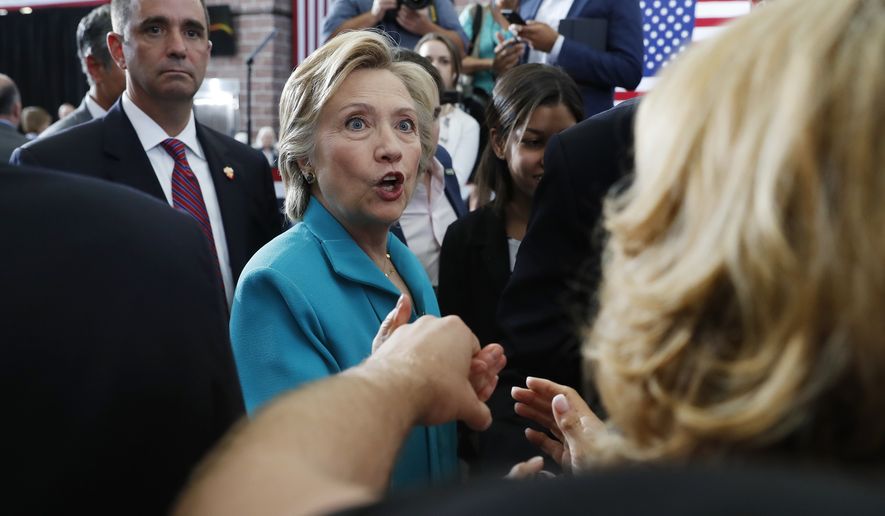OPINION:
Hillary Clinton has spent $75 million buying advertisements on television. In comparison, Donald Trump has spent $7.7 million.
At the end of June, Mrs. Clinton’s team had 651 paid staffers across the country, Mr. Trump’s team had 68.
And the mainstream media loves her. Some news anchors and pundits have even argued neutrality can’t be an option in this election cycle because of the divisive rhetoric of Mr. Trump. Mrs. Clinton held a 30-plus-minute speech addressing Mr. Trump’s racism — carried live on every network — shredding him apart using his own words.
And yet, Mrs. Clinton hasn’t been able to break, or hold onto, 50 percent in national and battleground-state polls.
A new NBC News/Survey Monkey poll released Tuesday shows Mrs. Clinton enjoys 48 percent support, compared to Mr. Trump’s 42 percent. Last week, she led by 8 percentage points. In a four-way general election matchup, her lead shrinks even further, to 41 percent compared to his 37 percent.
And let’s use four-way polling — because it’s the most honest. Libertarian Party candidate Gary Johnson is set to appear on all 50 state ballots. Some will have Green Party’s Jill Stein. Others (OK, just a handful) will have Evan McMullin.
A Public Policy Polling survey also released Tuesday found similar results. In a four-way race, Mrs. Clinton held 42 percent of the vote, compared with Mr. Trump’s 37 percent.
In battleground contests, polls are also tightening — and in none of them does Mrs. Clinton receive above 50 percent support, according aggregated polls by Real Clear Politics.
Why is this important?
Because some politicos believe undecideds usually break for the challenger — and there seems to be many undecideds late in this political race. Although Mrs. Clinton technically isn’t an incumbent, she’s running as one, promising to continue President Barack Obama’s legacy. That means Mr. Trump would be the challenger.
Pollster Nick Panagakis wrote a study in the late 1980s outlining what he dubbed “The incumbent rule” after analyzing more than 100 polls and finding that more than 80 percent of the time, the undecideds in polls voted for the challenger.
“An incumbent leading with less than 50 percent is frequently in trouble; how much depends on how much less than 50 percent,” Mr. Panagakis wrote. “A common pattern has been for incumbents ahead with 50% or less to end up losing.”
That’s Mrs. Clinton. Right now. In every poll.
Some, such as FiveThirtyEight pollster Nate Silver, have argued against the incumbent rule, but admits his reasoning isn’t foolproof.
“It is often asserted that this is the case — that the polls move toward the ’out-party’ candidate rather than the incumbent,” Mr. Silver writes. “But in my view the empirical evidence — although it is somewhat ambiguous — mostly argues against this idea.”
In the end, it doesn’t matter who is right, Mr. Panagakis or Mr. Silver. Because if you’re Mrs. Clinton, you don’t want to take the chance either way. You want to be leading in the polls by more than 50 percent, just for insurance’s sake.
And, by God, her team has done everything they can to put her in that position — carrying out a flawless convention, with an adoring press and the best political consultants and staffers money can buy.
Yet they can’t get her over the hump.
And so, right now, the Clinton camp is nervous. They should be.




Please read our comment policy before commenting.